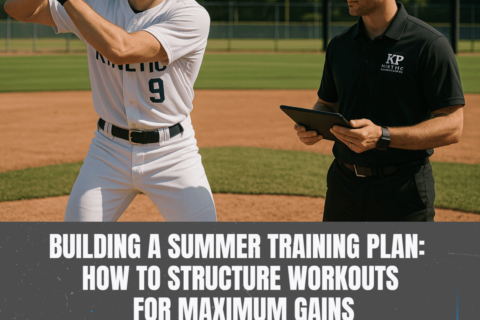Mission Critical: Why the Winter On-Ramp Still Defines a Pitcher’s Success and Health
Every year, as the air cools and the baseball calendar shifts, the same pattern emerges—pitchers disappear. They shut it down. They stop throwing. They tell themselves they’re “resting.”
But here’s the truth: the Winter is where healthy, durable, high-performing arms are built. It’s the phase that separates those who maintain from those who develop. And for the pitchers who dream of playing at the next level, there is no phase more misunderstood—or more important—than the Winter On-Ramp.
The Real Data Behind Arm Health
At KPI, we’ve seen the numbers firsthand and we’ve verified what MLB injury data has shown for years:
nearly 70% of arm injuries occur in the first two months of the season.
That’s not bad luck—it’s bad preparation.
The arm doesn’t break down because of “overuse.” It breaks down because the body wasn’t prepared to handle the demands of competition. Think about it—no one trains for a marathon by sitting still for two months and then running 26 miles. Yet, that’s how many pitchers approach the off-season.
When pitchers enter February under-trained, their bodies and nervous systems simply aren’t conditioned to handle the explosive stress of game-speed throwing. The arm can’t stabilize, the tissue can’t handle the load, and the result is predictable: soreness, inflammation, fatigue, and eventually injury.
The goal of the Winter On-Ramp is to build a body that can handle what’s coming. It’s the bridge between rest and readiness—the difference between surviving the season and thriving in it.
What a Modern Winter On-Ramp Looks Like
Four years ago, “on-ramping” was still a new concept for most pitchers. Today, it’s a KPI staple—and a science. The process hasn’t changed in principle, but the tools and insights we use have evolved dramatically.
Here’s how the system works now.
Phase 1: De-Load & Assessment
The Fall is the body’s reset button. Every pitcher at KPI begins with a period of low or no throwing to let the soft tissue regenerate. But instead of just “taking time off,” we use that window to collect data—force plate testing, Proteus rotational power, ArmCare strength metrics, and mobility assessments.
This data tells us how each pitcher’s body handled the previous season and what it needs next. It’s not rest for rest’s sake—it’s intelligent recovery with intent.
Phase 2: The On-Ramp
Once we know where a pitcher stands, we begin the build.
Our On-Ramp phase gradually increases throwing volume, intensity, and frequency over several weeks. Using daily ArmCare readings and force plate outputs, we monitor fatigue in real time and make adjustments on the fly.
This phase teaches the arm how to adapt again—slowly, deliberately, intelligently. It’s not about throwing harder yet; it’s about building the foundation that will let a pitcher throw harder safely.
Phase 3: Pitch Design & Command
Early winter is the perfect time to refine movement patterns and pitch shapes while intensity is still low. Using Trackman and the Newt Force Mound, our athletes learn how their delivery connects to their stuff—how small biomechanical adjustments translate into spin efficiency, vertical break, and command consistency.
The best pitchers don’t wait until they’re at 100% to learn feel—they develop it here, when the reps are intentional and repeatable.
Phase 4: Velocity Development
By midwinter, once the athlete’s tissues and movement patterns are ready, we introduce higher intensity throws and structured velocity training. This includes weighted-ball progressions, higher intent throwing tracked through radar, and mound velocity sessions monitored via Newt Force data to ensure the athlete is producing—not overreaching.
It’s common to see 2–4 mph increases during this phase, but the real success lies in how the body handles the new output. Our data-backed programming ensures pitchers don’t just throw harder—they stay durable while doing it.
Phase 5: Live AB Integration
Finally, pitchers move into live-at-bat sessions, where adrenaline, competition, and variability add the final layer of stress before the season begins. These outings are tracked using HitTrax and Trackman, ensuring feedback is objective, not emotional.
The goal: deliver pitchers to their high school, college, or pro programs at a 50-pitch high-intent baseline—healthy, conditioned, and confident.
The KPI Difference
Winter isn’t a downtime at KPI—it’s game time.
It’s when our technology and coaching come together to build the foundation of our athletes’ success. Force Plates guide the strength plan. Proteus drives rotational power. ArmCare tells us when to push and when to back off. And the Newt Force Mound gives us biomechanical force feedback that simply doesn’t exist anywhere else on the West Coast.
The system works because it’s not built on opinion—it’s built on objective data, applied by a coaching staff that lives this process every day.
Final Thoughts
If you’re a pitcher who’s serious about velocity, durability, and long-term development, the Winter On-Ramp isn’t optional—it’s non-negotiable.
The truth is simple:
Pitchers don’t get hurt because they throw too much.
They get hurt because they don’t prepare to throw enough.
Don’t rest your way into injury.
Train your way into performance.


